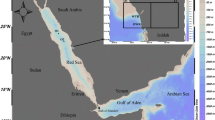Abstract
The occurrence of freak waves off the Brazilian coast was investigated through the analysis of data recorded by three buoys deployed in the south/southeast region, at a depth of 200 m. As well documented in the literature, these events are not rare, and more than 700 waves could be classified as abnormal based on the relation between the maximum wave height (H max) and the significant wave height (H s), H max ≥ 2H s. The use of other parameters suggested in the literature, as crest amplification index (crest height/H s ≥ 1.3) or a lower limit to the significant wave (H s ≥ 2 m), drastically reduced this number, resulting in a data set more representative of rogue waves. After applying these more strict criteria, only seven “true” freak waves were found. For the first time in Brazilian waters, it was possible to identify two freak waves in the same record. It was also investigated that an index analog to crest amplification, the trough amplification index (trough depth/H s), and several waves satisfied this new condition. The analyses of the asymmetry and directional spreading of measured spectra reveal no significant correlations between these parameters and freak waves. Probably due to the relative low energy of the area when compared to other regions, the longest wave period closer to a breaking condition is 10 s.



















Similar content being viewed by others
References
Banner ML, Gemmrich JR, Farmer DM (2002) Multiscale measurements of ocean wave breaking probability. J Phys Oceanogr 32(12):3364–3375
Candella RN, Candella MV (2010) Investigações sobre a Ocorrência de Ondas Anormais em Arraial do Cabo RJ. Revista Brasileira de Geofísica 28(4):551–561
Candella RN, Souza SML (2013) Ondas Oceânicas Extremas na Costa Sul-Sudeste Brasileira Geradas por Ciclone com Trajetória Anormal em Maio de 2011. Revista Brasileira de Meteorologia 28(4):257–266
Candella RN, Grosmann GS, Quental SHA (1999) Reconstituição de Condições de Ondas no Oceano Atlântico Sul com a Utilização de Modelo de Terceira Geração. Pesq. Nav., n. 12
Candella RN, Lomonaco DR, Marques da Cruz LM, Ferreira RS (2008) Análises Preliminares das Características Regionais das Ondas ao Longo da Costa Brasileira Através de Modelagem Numérica. II Congresso Brasileiro de Oceanografia, Fortaleza
Cavaleri L, Bertotti L, Torrisi L, Bitner-Gregersen E, Serio M, Onorato M (2012) Rogue waves in crossing seas: The Louis majesty accident. J Geophys Res 117:C00J10. doi:10.1029/2012JC007923
Chalikov D, Babanin AV (2012) Simulation of wave breaking in one-dimensional spectral environment. J Phys Oceanogr 42:1745–1761
de Pinho UF, Liu PC, Ribeiro CEP (2004) Freak waves at Campos Basin Brazil. Geofizika 21:53–67
Dean R (1990) Freak waves: a possible explanation. In: Tørum A, Gudmestad OT (eds) Water wave kinematics, Kluwer Academic Publishers, Norwell, pp 609–612
Didenkulova I, Anderson C (2010) Freak waves of different types in the coastal zone of the Baltic Sea. Nat Hazards Earth Syst Sci 10:2021–2029
Divinsky BV, Levin BV, Lopatukhin LI, Pelinovsky EN, Slyunyaev AV (2004) A freak wave in the Black Sea: observations and simulation. Doklady Earth Sci 395A:438–443
Godoi VA, Ribeiro CEP, Torres AR Jr (2014) An overview of events of high sea waves at the mouth of Guanabara Bay Pan-American. J Aquat Sci 9(2):70–87
Guedes Soares C, Cherneva Z, Antão EM (2003) Characteristics of abnormal waves in North Sea storm sea states. Appl Ocean Res 25:337–344
Guedes Soares C, Cherneva Z, Antão EM (2004) Steepness and asymmetry of the largest waves in storm sea states. Ocean Eng 31:1147–1167
Holthuijsen LH (2007) Waves in oceanic and coastal waters. Cambridge University Press, Cambridge (ISBN 978-0521860284)
Innocentini V, Caetano Neto ES (1996) A Case Study of the August 1988 South Atlantic Storm: numerical simulation of wave activity. Weather Forecast 11:78–88
Kharif C, Pelinovsky E (2003) Physical mechanisms of the rogue wave phenomenon. Eur J Mech B Fluid 22:603–634
Kharif C, Pelinovsky E, Slunyaev A (2009) Rogue waves in the ocean Advances in geophysical and environmental mechanics and mathematics. Springer, Berlin
Kuik AJ, van Vledder GPH, Holthuijsen LH (1988) A method for the routine analysis of pitch-and-roll buoy wave data. J Phys Oceanogr 18:102–1034
Lehner SH (2005) Extreme wave statistics from radar data sets. In: Proceedings of the 14th Aha Huliko`aWinter Workshop, Honolulu, Hawaii
Liu PC (2007) A chronology of freaque wave encounters. Geofizika 24(1):57–70
Liu P, Mori N (2000) Characterizing freak waves with wavelet transform analysis. Rogue Waves 2000 Workshop. Brest
Nikolkina I, Didenkulova I (2011) Rogue waves in 2006–2010. Nat Hazards Earth Syst Sci 11:2913–2924
Olagnon M, Van Iseghem S (2000) Some observed characteristics of sea states with extreme waves. In: Proceedings of the tenth international offshore and polar engineering conference, Seattle
Petrova P, Cherneva Z, Guedes Soares C (2006) Distribution of crest heights in sea states with abnormal waves. Appl Ocean Res 28:235–245
Sergeeva A, Slunyaev A (2013) Rogue waves, rogue events and extreme wave kinematics in spatio-temporal fields of simulated sea states. Nat Hazards Earth Syst Sci 13: 1759–1771. www.nat-hazards-earth-syst-sci.net/13/1759/2013/, doi:10.5194/nhess-13-1759-2013
Toffoli A, Babanin A, Onorato M, Waseda T (2010) Maximum steepness of oceanic waves: field and laboratory experiments. Geophys Res Lett 37(5). doi:10.1029/2009GL041771
Tomita H, Kawamura T (2000) Statistical analysis and inference from the in situ data of the Sea of Japan with reference to abnormal and/or freak waves. In: Proceedings of 10th ISOPE conference, Seattle, pp 116–122
Yuen HC, Lake BM (1982) Nonlinear dynamics of deep water gravity waves. In: Yih C-S (ed) Advances in applied mechanics, vol 22. Academic Press, New York, pp 67–229
Acknowledgments
The author is very grateful to Dr. Alexander Babanin (Faculty of Engineering and Industrial Sciences, Swinburne University of Technology, AU) and to Dr. José Henrique Alves (Marine Modeling and Analysis Branch Environmental Modeling Center NCEP/NOAA) for all their help and contributions to this work.
Author information
Authors and Affiliations
Corresponding author
Rights and permissions
About this article
Cite this article
Candella, R.N. Rogue waves off the south/southeastern Brazilian coast. Nat Hazards 83, 211–232 (2016). https://doi.org/10.1007/s11069-016-2312-2
Received:
Accepted:
Published:
Issue Date:
DOI: https://doi.org/10.1007/s11069-016-2312-2




